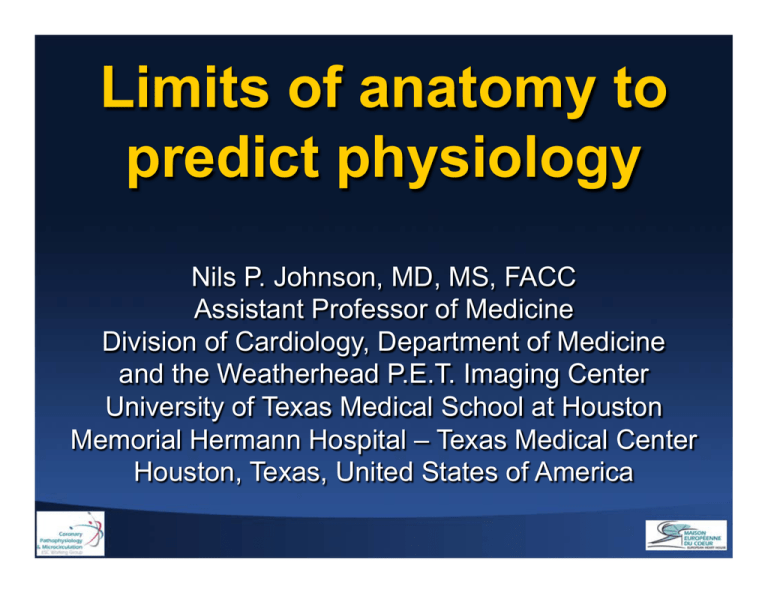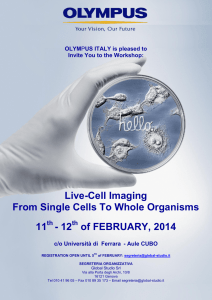Limits of anatomy to predict physiology
advertisement

Limits of anatomy to predict physiology Nils P. Johnson, MD, MS, FACC Assistant Professor of Medicine Division of Cardiology, Department of Medicine and the Weatherhead P.E.T. Imaging Center University of Texas Medical School at Houston Memorial Hermann Hospital – Texas Medical Center Houston, Texas, United States of America Disclosure Statement of Financial Interest Within the past 12 months, Nils Johnson has had a financial interest/ arrangement or affiliation with the organization(s) listed below. Affiliation/Financial Relationship • Grant/Research Support (pending to institution) • Non-disclosure agreements (non-financial) Company • St Jude Medical • Volcano Corporation • • St Jude Medical Volcano Corporation However, Nils Johnson has never personally received any money from any commercial company. “If you want new ideas, read old books” -attributed to Ivan P. Pavlov (Russian physiologist, 1849-1936, Nobel prize 1904, “Pavlov’s dog”) “cardiologists continue to base major clinical decisions about coronary artery disease on inferences … based largely on … morphological data, such as provided by the coronary arteriogram” CT angiogram angiogram Koo BK, JACC 58(19):1989, 2011, Figure 1, panel A infer significance decision Invasive angiogram CT angiogram anatomy Koo BK, JACC 58(19):1989, 2011, Figure 1, panel A infer (predict) physiology Invasive angiogram Anatomy to predict physiology %DS linked to CFR – 1974 Stenosis flow reserve (SFR) – 1986 CT-modeled FFR (FFRCT) – 2010 Anatomic predictions accurate (work well on average) imprecise (uncertain for an individual) Physiology variable (here FFR) 1.0 0.8 0.6 0.4 0.2 0 0% 20% 40% 60% 80% Anatomy variable (here %DS) 100% Measurement uncertainty • CT angiography resolution ≈ 0.6 mm • Invasive angiography ≈ 0.2 mm • IVUS ≈ 0.1 mm • OCT ≈ 0.02 mm • Pressure wire ≈ 1 mmHg “Left main” stenosis 4.4mm 50%DS 2.2mm ΔP Poiseuille law: ΔP ∝ 1 / radius4 “Left main” stenosis 4.4mm 50%DS 2.2mm ΔP Relative error ΔP/P = 4 * Δradius / radius • CTA = 4*0.6/1.1 = 218% error in ΔP • Invasive = 4*0.2/1.1 = 73% • IVUS = 4*0.1/1.1 = 36% • OCT = 4*0.02/1.1 = 7% Test/retest repeatability • FFR ±0.02 • %DS ±5-8% by QCA 2 • MLA ±0.3-0.6 mm • MLD ±0.1-0.3 mm Johnson NP, Circ Cardiovasc Imaging 6(5):817, 2013, summary of Table 1 Biologic variability N = 1,500 consecutive PET scans group vs individual mode = 2.72 (most common) mean = 3.04 ± 0.97 median = 2.95 (IQR 2.32-3.68) range from 0.58 to 7.13 # Average CFR for entire LV Johnson NP, JACC Cardiovasc Imaging 5(4):430, 2012, unpublished data %DS fractional flow reserve (FFR) 1.0 0.9 0.8 0.7 0.6 0.5 n=4,442 0.4 0.3 0% 20% 40% 60% 80% QCA diameter stenosis (%) Johnson NP, Circ Cardiovasc Imaging 6(5):817, 2013, Figure 1A Unpublished, multicenter data 100% %DS Stenosis flow reserve (SFR) • Introduced in 1986 • Gould and Kirkeeide • Anatomy from QCA • Modeled CFR • Commercially available from Philips CT-modeled FFR (FFRCT) • Introduced in 2010 • Taylor and colleagues • Anatomy from CT angiogram • Modeled FFR • Commercial distribution by HeartFlow (not yet in USA) QCA-modeled CFR Johnson NP, Circ Cardiovasc Imaging 6(5):817, 2013, Figure 3A Bartúnek J, JACC 26(2):328, 1995, Figure 3 (bottom) CT-modeled FFR Johnson NP, Circ Cardiovasc Imaging 6(5):817, 2013, Figure 4A Koo BK, JACC 58(19):1989, 2011, Figure 4 CT-modeled FFR Johnson NP, Circ Cardiovasc Imaging 6(5):817, 2013, Figure 5A CT-modeled FFR DISCOVER-FLOW (2011) DeFACTO (2012) DISCOVER FLOW = Koo BK, JACC 58(19):1989, 2011, Figure 4 DeFACTO = Nakazato R, Circ Cardiovasc Imaging 6(6):881, 2013, Figure 1A NXT = Nørgaard BL, JACC 63(12):1145, 2014, Figure 3 NXT (2013) Physiology models Model Author SFR Year N Correlation AUC Accuracy Bartúnek 1995 110 0.78 0.89 84% Di Mario 1996 21 0.57 0.87 80% FFRCT DISCOVER-FLOW 2011 159 0.68 0.90 84% DeFACTO 2012 407 0.63 0.81 69% NXT 2014 251 0.82 0.90 81% little Δ in 20 yrs “Albeit often statistically significant, the correlations between angiographic and functional indices … are too weak to be clinically relevant” “too weak to be clinically relevant” Toth G, Eur Heart J. 2014 Mar 18. [Epub ahead of print], Figure 1A
